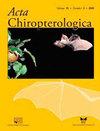哥斯达黎加沿海拔梯度的蝙蝠群
IF 0.7
4区 生物学
Q4 ZOOLOGY
引用次数: 0
摘要
研究了哥斯达黎加一个新热带蝙蝠群落连续17个月的物种丰富度、Hill数、每物种捕获量、摄食行会、性别比和生物量的时空格局,在海拔梯度上分别为:低50 ~ 150 m、中低375 ~ 500 m、中高975 ~ 1050 m和高1950 ~ 2050 m。我们发现海拔高度对物种丰富度有影响。正如预期的那样,物种丰富度在低海拔地区高;然而,出乎意料的是,我们注意到物种丰富度在中高波段最高,这种多样性模式以前没有在蝙蝠中记录过。降水周期对物种丰富度也有影响;特别是在中高海拔地区,当降水量为中等和最高时,我们观察到的物种数量更多。通过对数据进行单独分析,我们发现海拔高度对3个群落物种丰富度的影响:动物性食性蝙蝠在中低带多样性更大,食性食性蝙蝠在中高带和高带多样性更大,而食性食性蝙蝠在中低带和低带多样性更大。降水量对食果蝙蝠的物种丰富度也有影响;当降雨量为中、高时,群落的物种丰富度较高。海拔高度对食虫、杂食性和吸血群落的物种丰富度没有影响,对物种捕获、性别比和生物量也没有影响。我们的研究结果不仅为低地森林作为高物种多样性水库的重要性提供了进一步的证据,而且还强调了热带前山地雨林对蝙蝠群落保护的重要性,因为它们具有高物种丰富度,特别是对食蚁兽和果食蚁兽群落。这一点尤其重要,不仅因为该生态系统受到新热带地区土地利用变化的严重影响,而且还因为该海拔高度预测的未来降水减少可能会影响整体物种丰富度,特别是某些摄食群落。因此,该生活区的保护工作对于维持海拔梯度下蝙蝠群落的功能和生态多样性至关重要。本文章由计算机程序翻译,如有差异,请以英文原文为准。
Bat Assemblages along an Elevational Gradient in Costa Rica
Spatio-temporal patterns of species richness, Hill numbers, captures per species, feeding guilds, sex ratio, and biomass were studied in a Neotropical bat assemblage during 17 continuous months in four bands (low: 50–150, mid-low: 375–500, mid-high: 975–1,050, and high: 1,950–2,050 m a.s.l.) in an elevational gradient in Costa Rica. We found an effect of elevation on species richness. As expected, species richness was high in the low elevations; unexpectedly, however, we noted that species richness was highest in the mid-high band, a diversity pattern that has not been previously recorded in bats. We also found an effect of precipitation periods on species richness; in particular, at mid-high elevations, when precipitation was intermediate and highest, we observed a larger number of species. When analyzing data separately by feeding ensemble, we found an effect of elevation on species richness for three ensembles: animalivorous bats were more diverse at the mid-low band, nectarivorous bats were more diverse in the mid-high and high bands, and frugivorous bats were more diverse in the mid-low and low bands. Species richness of frugivorous bats was also affected by precipitation; when rainfall was intermediate and highest, we noted a higher species richness of this ensemble. There was no effect of elevation on species richness for the insectivorous, omnivorous or hematophagous ensemble, nor on the species capture, sex ratio or biomass. Our results not only provide further evidence of the importance of lowland forests as reservoirs of high species diversity, but also highlight the importance of tropical premontane rainforests for the conservation of bat communities given their high species richness, particularly for the nectarivorous and frugivorous ensembles. This is particularly relevant not only because this ecosystem has been heavily affected by land use changes in the Neotropical region, but also because the predicted future decrease of precipitation at this elevation could potentially affect overall species richness and particularly for certain feeding ensembles. Thus, conservation efforts in this life zone are of critical importance for maintaining functional and ecological diversity of bat communities in elevational gradients.
求助全文
通过发布文献求助,成功后即可免费获取论文全文。
去求助
来源期刊

Acta Chiropterologica
生物-动物学
CiteScore
2.50
自引率
20.00%
发文量
42
审稿时长
>12 weeks
期刊介绍:
Acta Chiropterologica, published by the Museum and Institute of Zoology at the Polish Academy of Sciences, is devoted solely to the study and discussion of bats.
 求助内容:
求助内容: 应助结果提醒方式:
应助结果提醒方式:


